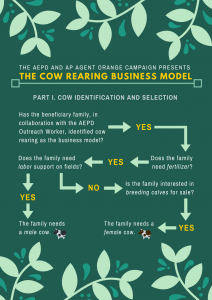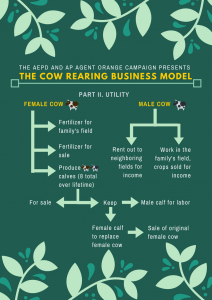During my first field visit to the Tuyen Hoa and Bo Trach districts I met with Mr. Thin, Mr. Phuc, and Ms. Toa’s family. To my surprise, all three families, in partnership with their AEPD Outreach Worker, have selected cow rearing as their business model. (Point of clarification: Mr. Thin’s plan is currently being funded, Mr. Phuc’s plan has just been funded in July 2018, and Ms. Toa’s family has just been profiled in January 2018.)
So, why a cow? To be fair, each family has the opportunity to elect any business model that works best for them and their needs. The cow rearing business model happens to be popular among the campaign’s beneficiaries for several reasons. Most of the caregivers the campaign supports are aging and cannot feasibly manage intensive manual labor as well as they used to. Cow rearing represents a manageable and sustainable endeavor for them.
How does the cow rearing model work? For these three families, it begins with the purchase of a female cow and calf. In other situations, the beneficiaries may select a male cow. The female cow and calf’s purpose and benefits are multi-faceted. Among the benefits is the utility of the cow’s manure for the owner’s land and the additional income the families can earn by selling the calves. (A female cow can typically produce up to eight calves in her lifetime.) When possible, the beneficiaries receive both a female cow and calf to help them get a head start.
Part I. A graphic on how a cow is identified and selected after the cow rearing business model is chosen. The critical assumptions of this model and the Agent Orange Campaign are two-fold: (1) the family is in need of a sustainable source of income and (2) the business model is developed with three key characteristics in mind—feasibility, longevity, and sustainability.
On occasion, depending on the circumstances and the cow’s condition, the family will decide to sell the cow and keep the calf. For example, if the calf is a male, he may be used to work in the fields (either the family’s or rented out to neighboring farmers). Or, if the calf is a female and the cow is nearing the end of her reproductive years, they may keep the calf to bear more calves and sell the cow. The cycle continues.
Part II. The utility of a female versus a male cow based on the beneficiary family’s identified needs. AEPD and AP recognize that the family’s needs may change over time and that they are agents of their business plan. The AEPD Outreach Worker and AP Peace Fellow will continue to monitor the family’s progress and evaluate the outcome and eventually impact of the Campaign. The utility of the cow rearing model is non-linear and does not restrict the number of cows the family will eventually have at any given point in time.
Thus, the cow rearing business plan is a powerful tool for sustainable development, income generation, and financial literacy. It is our hope that through this program and these outcomes, the beneficiaries – Agent Orange-affected families – will have an improved quality of life especially as they age and continue to care for their loved ones. We are committed to monitoring and evaluating the progress of this program and supporting additional families to come.
So, why a cow? Because (simply put) it’s a sustainable and, often, familiar livelihood that is accessible and impactful to Agent Orange-affected families. Are you interested in supporting a cow rearing business model? Click here to invest in our tenth campaign beneficiary, Mr. Thin’s family, and their plans to raise a cow and a calf.
Posted By Marcela De Campos (Vietnam)
Posted Jul 19th, 2018




2 Comments
Corinne Cummings
July 23, 2018
Hi Marcela, this is a very insightful blog post! Thank you for sharing such valuable information, I did not know that cows were so crucial to sustainable development until your posting. You explained the information thoughtfully, and the diagrams that you provided were helpful too. I can see how this program offers prosperous results to those affected by Agent Orange. I am so proud of all your efforts Marcela — continue the excellent work out in the field. We are impressed! Until your next blog post, take care. Best, Corinne
Princia Vas
July 23, 2018
Its amazing how something as simple as a cow can help a family like Mr. Thin’s sustain economically! It was nice reading about the cow rearing model and how it works 🙂